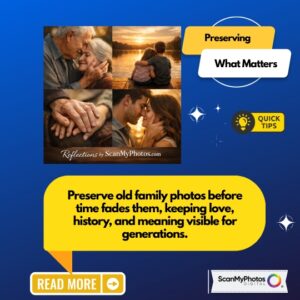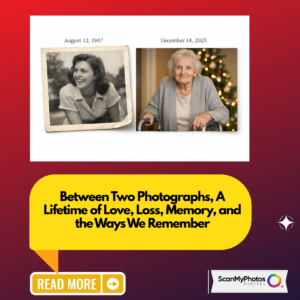Welcome to the ScanMyPhotos Journal. Today we share “How to Declutter Your Space & Memories by Digitizing Family Nostalgia.”
If you’ve discovered this article, you probably don’t need much encouragement to declutter your home. But in case you do, consider this:
- Less clutter makes your home more spacious and liveable.
- Less clutter makes your home look expensive because it’s easier to stay organized.
- Disorganization costs money.
- Less clutter makes your home more beautiful because you can use the space for decoration instead of storage.
- Less clutter makes your home safer because there are fewer things to trip over and wider spaces to move in.
Bottom line: It’s good to declutter. The trouble is dealing with nostalgic items, like photos, term papers, graduation certificates, and Christmas cards. You don’t need these things in your daily life, but you don’t want them entirely out of your life, either.
Digitizing your nostalgic keepsakes is one of the best modern solutions to this dilemma. Let’s talk about how to do it.
[Tweet “How to Declutter Your Space & Memories by Digitizing Family Nostalgia”]
Digitizing Nostalgia & Uncluttering Your Space 101
The first step in digitizing your nostalgia is to triage your stuff. Find a place to put all the things you want to keep but don’t have space for, and divide it into three piles:
- Easy Items: Flat objects no larger than a piece of letter paper, for which you don’t need the original if you can be confident of a safe digital solution.
- Harder Items: Flat objects for which you need the original; larger flat objects whether or not you need the original; anything bound in a book.
- Odds and Ends: Objects you would like to digitize but don’t know how because they aren’t flat or are inappropriate for storage.
You can do this for all the keepsakes in your home at once or go room by room. Once you have your initial batch of triaged items, deal with each pile one by one.
Easy Items
Easy items include:
- Photos
- Love letters
- Letters of recommendation
- Holiday and birthday cards
- Thank-you notes
Scan Them
If you have a scanner, simply stack the items in a neat pile, sorted by size for ease. Scan them one by one until you’re finished, according to the instructions for your device.
If you have a regular office scanner, this works fine if you’re scanning 20 or fewer pieces. But it can get tedious if you’re doing large stacks of photos and papers. With larger jobs, you can invest several hundred dollars in a high-speed scanner or work with a scanning service that does the work for you.
Throw Them Away
This can be the most challenging part of dealing with these easier items: letting them go once you’ve made digitized copies. Remember, you’ve already established you don’t need the originals. The only reason you want to hold on to them is that you’re afraid of losing the digital files.
If you scanned the items yourself, you can get terabytes of digital, off-site, secure, backed-up storage for less than $10 a month from services like Google Drive and Carbonite.
Having one copy there and one on your home network is safer than keeping the physical copies in a box somewhere that could get stolen or damaged by fire, water, or rodents. If you use a service, ask if they offer backup services.
Harder Items
These include several types of items.
1. Vital Documents
These are documents like your birth certificate, Social Security card, and marriage license, for which some procedures require you to present the original.
At first, you might wonder why you should scan these items when you’re keeping the originals. The answer is security. Should you lose the original, you can get a “replacement original” from the issuing authority, and that process is much faster, easier, and cheaper if you can reference a copy.
Your first step with these is to scan them in with the rest of your easy scannables. Then, store the original in a safe place. Some options include a fireproof safe or filing cabinet, a secure storage facility that’s bonded and insured, or a safe deposit box.
2. Sentimental Items
These are items for which you don’t technically need the original but which you still want to keep. Some examples include:
- Wedding and birth photos
- Graduation certificates
- Your favorite love letters
- Cards commemorating extraordinary occasions
Consider framing these sentimental keepers and turning them into art for your home. You might be surprised how creative you can get.
3. Larger Scannable Items
These are larger than a standard letter-size piece of paper. They include:
- Many graduation certificates
- Large photos
- Art projects and collages
- Event posters
Many personal scanners can’t handle legal-size paper, so this list will also include most of your essential banking and loan documents, like your mortgage. Whatever the item, you have three options:
Cut It Up
If the margins are right, you can take scissors to the originals and scan them piece by piece. Once all the images are on your computer, you can digitally reassemble them into the original or something close enough to it.
Shrink It
Take the item to your local copy shop and photocopy it with size reduction until it fits onto a piece of letter-sized paper. Then take it home and scan it like you did the other easy documents. If you take this route, make sure you use a copier to make high-resolution copies so you don’t lose image quality in the transfer.
Send It In
Those professional digitization services we mentioned don’t just have super-speed scanners. Many also have super-sized scanners capable of handling larger items. Some also have a digital camera on precision rails. They are used to take high-quality photos of the largest objects, then assemble the pieces like in our Cut it Up option, only without cutting up your original.
4. Books & Albums
Some bound items on your shelf take up space, but you haven’t opened them in years. You can donate many books to the library, but some things you must keep. These include:
- Photo albums
- Yearbooks
- The signature book from your wedding
- Guidebooks from vacations
- College textbooks with nostalgic notes
- Diaries and journals
If you have a steady hand, it’s possible to use a craft knife and cut the pieces out of these books one at a time. When you’re done, you’ll have another stack of easily scanned pages ready to go.
But if that makes you nervous, it’s best to trust a professional. Scanning services have precision setups and specialist personnel who can get the best possible scans from these books without damaging them.
Either way, once you’ve scanned the books, you need to get them out of your space. After all, that’s the point of this exercise. Options include gifting them to other people for which they have meaning, putting them in deep storage, or disposing of them in a ceremonial bonfire (a safe fire with an extinguisher nearby).
Odds and Ends
Our final category includes all those objects you keep for nostalgic reasons that aren’t flat and easy to scan. These include:
- VHS tapes and other home videos
- Photo negatives
- Slides from vacations and events
- Trophies and medals
- Joke T-shirts
- Souvenirs
- Stuffed animals
Also in this category is what author Robert Fulghum calls the gummy lump: Items your kids made that are strewn about your house.
Odds and ends fall into two categories: media items and non-media items.
Media
Media includes images and slides you made before the digital age. If your home is like most, you have at least one such item in a format you can’t even play anymore.
Your best bet here is to go with a media conversion service. Some scanning companies like ScanMyPhotos.com offer this in addition to regular scanning, but not all. If you have lots of media to convert, get a quote for both so you can qualify for the best possible bulk discount.
If you have the equipment and the patience, it’s possible to do these conversions yourself. But unless you already know-how, it will take less time and cost less money to have a professional service do it.
Non-Media Items
You’ve done an excellent job thus far, and all that’s left are the physical souvenirs of your journey through life. If you ask a hundred home organization experts what to do about these, you’ll get a hundred different answers (two hundred if you come back and ask them again in a year). Most of them boil down to variations on one of three themes:
Say Thank You, Then Say Goodbye
This is exactly what it sounds like. Spend a few minutes with each item, mindfully thinking about its role in your life. Say thank you to it — out loud — and then find a new place for it to be. That may be as a gift to a friend or a donation to a charity.
Photo Finish
With this option, you take a dozen high-quality photos of each item, then choose your favorite. Insert it in with your other collections of scans and images, then enjoy seeing it each time you go down memory lane. Then, send the item on to its next place, just as you would with the thank you/goodbye option above.
The Seasonal Collection
If you really can’t bear to part with some of these items, but they still take up too much space, take a hint from your local museums. Get three storage tubs and divide your collection into four groups: one each for autumn, spring, summer, and winter.
One-quarter of your memorabilia stays in your living space. The rest goes into storage, at home, or in a unit off-site. Once a quarter, you trade the items out. You get to keep your treasures and appreciate them more as you see them anew each year, but you still clear out much of your clutter.
Final Thought: Bench Strength
One of the reasons we’re resistant to digitizing old photos and other memorabilia is the illusion of safety physical objects provide. We say “illusion” because physical items can be damaged by any number of things. Digital copies are harder to destroy because it’s so easy and inexpensive to create backup copies.
Experts in digital security recommend keeping three copies of any necessary file in the following three ways:
- One copy on your main computer or network for easy access when needed
- One copy on a separate drive kept on the property you own, which you back up once a month
- One copy at an off-site, cloud-type storage facility, backed up once a month or once a quarter
That may be going overboard for many private homes, but if you can do this, it will help you overcome that feeling of impermanence many people have about digital copies. Your memories will be safe and your spaces cleaner.
SOURCE: Shawn Russell is a freelance journalist in Chicago. He’s a single dad of a 13-year-old daughter who has helped him digitize his memorabilia.
Follow ScanMyPhotos on Twitter






